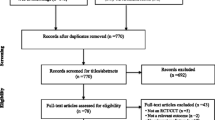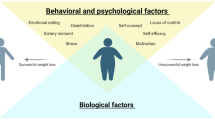Abstract
Background
Understanding the factors that influence successful weight control is critical for developing interventions.
Purpose
The purpose of the study was to provide a comprehensive understanding of the role of psychosocial, environmental, and behavioral variables in distinguishing weight-loss maintainers (WLM) from treatment-seeking obese (TSO).
Methods
WLM (n = 167) had lost ≥10% of their maximum body weight, had kept the weight off for ≥5 years, and were now of normal weight. TSO-1 and TSO-2 had a history of dieting and body mass index ≥25. TSO-1 was predominantly Caucasian; TSO-2 was predominantly African-American. Bayesian model averaging was used to identify the variables that distinguished WLM from TSO-1 and TSO-2.
Results
The variables that most consistently discriminated WLM from TSO were more physical activity (ORs = 3.95 and 2.85), more dietary restraint (ORs = 1.63 and 1.41), and less dietary disinhibition (ORs = 0.69 and 0.83). Environmental variables, including the availability of physical activity equipment, TVs, and high-fat foods in the home, also distinguished WLM from TSO.
Conclusions
Obesity treatment should focus on increasing conscious control over eating, engaging in physical activity, and reducing disinhibition. Changes in the home environment may help facilitate these behavioral changes.
Similar content being viewed by others
References
Butryn ML, Phelan S, Hill JO, Wing RR. Consistent self-monitoring of weight: A key component of successful weight loss maintenance. Obesity. 2007; 15: 3091–3096.
Raynor DA, Phelan S, Hill JO, Wing RR. Television viewing and long-term weight maintenance: Results from the National Weight Control Registry. Obesity. 2006; 14: 1816–1824.
Klem ML, Wing RR, McGuire MT, Seagle HM, Hill JO. A descriptive study of individuals successful at long-term maintenance of substantial weight loss. Am J Clin Nutr. 1997; 66: 239–246.
Wing RR, Phelan S. Long-term weight loss maintenance. Am J Clin Nutr. 2005; 82: 222S–225S.
Phelan S, Wyatt HR, Hill JO, Wing RR. Are the eating and exercise habits of successful weight losers changing? Obesity. 2006; 14: 710–716.
Kayman S, Bruvold W, Stern JS. Maintenance and relapse after weight loss in women: Behavioral aspects. Am J Clin Nutr. 1990; 52: 800–807.
Ogden J. The correlates of long-term weight loss: A group comparison study of obesity. Int J Obes Relat Metab Disord. 2000; 24: 1018–1025.
Dohm FA, Beattie JA, Aibel C, Striegel-Moore RH. Factors differentiating women and men who successfully maintain weight loss from women and men who do not. J Clin Psychol. 2001; 57: 105–117.
Koch FS, Sepa A, Ludvigsson J. Psychological stress and obesity. J Pediatr. 2008; 153: 839–844.
Maio GR, Haddock GG, Jarman HL. Social psychological factors in tackling obesity. Obes Rev. 2007; 8(Suppl 1): 123–125.
Hill JO, Wyatt HR, Reed GW, Peters JC. Obesity and the environment: Where do we go from here? Science. 2003; 299: 853–855.
Jordan PJ, Ory MG, Goldman Sher T. Yours, mine, and ours: The importance of scientific collaboration in advancing the field of behavior change research. Ann Behav Med. 2005; 29: 7–10.
Wing RR, Papandonatos G, Fava JL, et al. Maintaining large weight losses: The role of behavioral and psychological factors. J Consult Clin Psychol. 2008; 76: 1015–1021.
Gorin AA, Phelan S, Hill JA, Wing RR. Promoting long-term weight control: Does dieting consistency matter? Int J Obes Relat Metab Disord. 2004; 28: 278–281.
Gorin AA, Wing RR, Fava JL, et al. Weight loss treatment influences untreated spouses and the home environment: Evidence of a ripple effect. Int J Obes (Lond). 2008; 32: 1678–1684.
Block G, Hartman AM, Naughton D. A reduced dietary questionnaire. Epidemiol. 1990; 1: 58–64.
Smiciklas-Wright H, Mitchell D, Derr J. Internal and external interviewer reliability for telephone-administered dietary recalls using the Minnesota Nutrition Data System (NDS). In: First International Conference on Dietary Assessment Methods: Minneapolis, MN; 1992.
Stunkard AJ. “Restrained eating”: What it is and a new scale to measure it. In: Cioffi LA, James WPT, VanItallie TB, eds. The Body Weight Regulatory Systems: Normal and Disturbed Mechanisms. New York: Raven; 1981: 243-251.
Eck LH, Klesges RC, Hanson CL, White J. Reporting retrospective dietary intake by food frequency questionnaire in a pediatric population. J Am Diet Assoc. 1991; 91: 606–608.
Boucher B, Cotterchio M, Kreiger N, Nadalin V, Block T, Block G. Validity and reliability of the Block98 food-frequency questionnaire in a sample of Canadian women. Public Health Nutr. 2006; 9: 84–93.
Paffenbarger RS Jr, Hyde RT, Wing AL, Lee IM, Jung DL, Kamert JB. The association of changes in physical-activity level and other lifestyle characteristics with mortality among men. New Engl J Med. 1993; 328: 538–545.
Washburn RA, Smith KW, Goldfield SRW, McKinlay JB. Reliability and physiologic correlates of the Harvard Alumni Activity Survey in the general population. J Clin Epidemiol. 1991; 44: 1319–1326.
Siconolfi SF, Lasater TM, Snow RCK, Carleton RA. Self-reported physical activity compared with maximal oxygen uptake. Am J Epidemiol. 1985; 122: 101–105.
Jacobs DR, Hahn LP, Haskell WL, Pirie P, Sidney S. Validity and reliability of short physical activity history: CARDIA and the Minnesota Heart Health Program. Cardiopul Rehab. 1989; 9: 448–459.
French SA, Harnack L, Jeffery RW. Fast food restaurant use among women in the Pound of Prevention study: Dietary, behavioral and demographic correlates. Int J Obes Relat Metab Disord. 2000; 24: 1353–1359.
Stunkard AJ, Messick S. The Three-Factor Eating Questionnaire to measure dietary restraint, disinhibition and hunger. J Psychosom Res. 1985; 29: 71–83.
Hyland ME, Irving SH, Thacker C, Dann PL, Dennis I. Psychometric analysis of the Stunkard-Messick Eating Questionnaire (SMEQ) and comparison with the Dutch Eating Behavior Questionnaire (DEBQ). Curr Psychol, Res Rev. 1989; 98: 228–233.
Phelan S, Wyatt HR, HIll JO, Wing RR. Are the eating and exercise habits of successful weight losers changing? Obes Res. 2006; 14: 710–716.
Gorin AA, Phelan S, Wing RR, Hill JO. Promoting long-term weight control: Does dieting consistency matter? Int J Obes Relat Metab Disord. 2004; 28: 278–281.
Block G, Woods M, Potosky A, Clifford C. Validation of a self-administered diet history questionnaire using multiple diet records. J Clin Epidemiol. 1990; 43: 1327–1335.
Raynor HA, Polley BA, Wing RR, Jeffery RW. Is dietary fat intake related to liking or household availability of high- and low-fat foods? Obes Res. 2004; 12: 816–823.
Jakicic JM, Wing RR, Butler BA, Jeffery RW. The relationship between presence of exercise equipment in the home and physical activity level. Am J Health Prom. 1997; 11: 363–365.
Sallis JF, Grossman RM, Pinski RB, Patterson TL, Nader PR. The development of scales to measure social support for diet and exercise behaviors. Prev Med. 1987; 16: 825–836.
Radloff LS. The CES-D Scale: A self-report depressive scale for research in the general population. J Appl Psychol Meas. 1977; 1: 385–401.
Myers JK, Weissman MM. Use of a self-report symptom scale to detect depression in a community sample. Am J Psychiatr. 1980; 137: 1081–1084.
Raftery AE. Approximate Bayes factors and accounting for model uncertainty in generalized linear models. Biometrika. 1996; 83: 251–266.
McGuire MT, Wing RR, Klem ML, Lang W, Hill JO. What predicts weight regain in a group of successful weight losers? J Consult Clin Psychol. 1999; 67: 177–185.
Tiggemann M. Dietary restraint as a predictor of reported weight loss and affect. Psychol Rep. 1994; 75: 1679–1682.
Heatherton TF, Polivy J, Herman CP. Restraint, weight loss, and variability of body weight. J Abnorm Psychol. 1991; 100: 78–83.
Niemeier HM, Phelan S, Fava JL, Wing RR. Internal disinhibition predicts weight regain following weight loss and weight loss maintenance. Obesity. 2007; 15: 2485–2494.
Phelan S, Roberts M, Lang W, Wing RR. Empirical evaluation of physical activity recommendations for weight control in women. Med Sci Sports Exerc. 2007; 39: 1832–1836.
Gortmaker SL, Must A, Sobol AM, Peterson K, Colditz GA, Dietz WH. Television viewing as a cause of increasing obesity among children in the United States, 1986–1990. Arch Pediatr Adolesc Med. 1996; 150: 356–362.
Gortmaker SL. Innovations to reduce television and computertime and obesity in childhood. Arch Pediatr Adolesc Med. 2008; 162: 283–284.
Gorin AA, Raynor HA, Niemeier HM, Wing RR. Home grocery delivery improves the household food environments of behavioral weight loss participants: Results of an 8-week pilot study. Int J Behav Nutr Phys Act. 2007; 4: 58.
Baumeister RF, Vohs KD. Handbook of Self-Regulation: Research, Theory, and Applications. New York: Guilford; 2004.
Kanfer FH. Self-management methods. In: Kanfer FH, Goldstein AP, eds. Helping People Change. New York: Pergamon; 1975: 309–356.
Hayes SC, Wilson KG, Gifford EV, Follette VM, Strosahl K. Experimental avoidance and behavioral disorders: A functional dimensional approach to diagnosis and treatment. J Consult Clin Psychol. 1996; 64: 1152–1168.
Rachlin H. The Science of Self-Control. Cambridge: Harvard University Press; 2000.
Ricciardelli LA, Williams RJ, Finemore J. Restraint as misregulation in drinking and eating. Addict Behav. 2001; 26: 665–675.
Wing RR, Tate DF, Gorin AA, Raynor HA, Fava JL. A self-regulation program for maintenance of weight loss. N Engl J Med. 2006; 355: 1563–1571.
Brown JM. Self-regulation and the addictive behaviors. In: Miller WR, Heather N, eds. Treating addictive behaviors. New York: Plenum; 1998: 61–73.
Muraven M, Baumeister RF. Self-regulation and depletion of limited resources: Does self-control resemble a muscle? Psychol Bull. 2000; 126: 247–259.
Baumeister RF, Bratslavsky E, Muraven M, Tice DM. Ego depletion: Is the active self a limited resource? J Pers Soc Psychol. 1998; 74: 1252–1265.
Vohs KD, Heatherton TF. Self-regulatory failure: A resource-depletion approach. Psychol Sci. 2000; 11: 249–254.
Boutelle K, Baker R, Kirschenbaum D, Mitchell M. How can obese weight controllers minimize weight gain during the high risk holiday season? By self-monitoring very consistently. Health Psychol. 1999; 18: 364–368.
Sperduto WA, Thompson HS, O'Brien RM. The effect of target behavior monitoring on weight loss and completion rate in a behavior modification program for weight reduction. Addict Behav. 1986; 11: 337–340.
Jakicic JM, Marcus BH, Lang W, Janney C. Effect of exercise on 24-month weight loss maintenance in overweight women. Arch Intern Med. 2008; 168: 1550–1559. discussion 9–60.
Agras W, Telch C, Arnow B, Eldredge K, Marnell M. One-year follow-up of cognitive–behavioral therapy for obese individuals with binge eating disorder. J Clin Psychol. 1997; 65: 343–347.
Wilfley DE, Welch RR, Stein RI, et al. A randomized comparison of group cognitive–behavioral therapy and group interpersonal psychotherapy for the treatment of overweight individuals with binge-eating disorder. Arch Gen Psychiatry. 2002; 59: 713–721.
Author information
Authors and Affiliations
Corresponding author
Additional information
This research was supported by the National Institutes of Health grant DK066787 supplement.
About this article
Cite this article
Phelan, S., Liu, T., Gorin, A. et al. What Distinguishes Weight-Loss Maintainers from the Treatment-Seeking Obese? Analysis of Environmental, Behavioral, and Psychosocial Variables in Diverse Populations. ann. behav. med. 38, 94–104 (2009). https://doi.org/10.1007/s12160-009-9135-2
Published:
Issue Date:
DOI: https://doi.org/10.1007/s12160-009-9135-2




